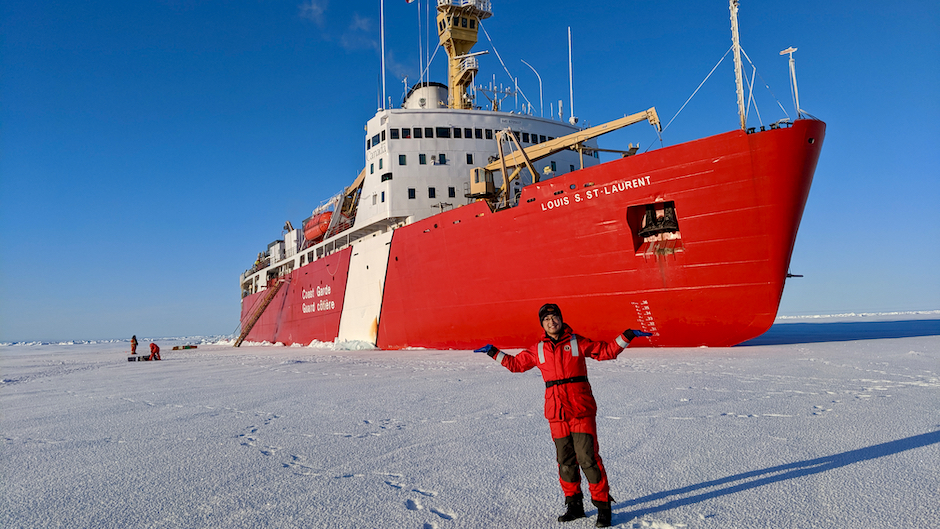As a Rosenstiel Ph.D. student, I was fortunate to study changes in the Arctic climate while heading for the North Pole on board the Canadian Coast Guard icebreaker Louis S. St-Laurent. I believe every ocean science researcher should gain an appreciation for the difficulty of collecting and analyzing data onboard ship, and also experience the fulfillment that comes from working at sea.
I am a doctoral candidate in the Rosenstiel School’s remote sensing group, led by Professor Peter Minnett in the Department of Ocean Sciences. The group's research is primarily concentrated on satellite remote sensing of the sea surface, microscale effects occurring at the sea surface, diurnal heating of the upper ocean, and the physics of the Arctic.
Although I have received a good education and done many experiments in labs, I know practice in the real world can be quite different from the theory and I have a strong motivation to test my knowledge through working at sea. At the Rosenstiel School, bigger and more challenging opportunities opened up.
In 2018, I participated in the U.S. research icebreaker Nathaniel B Palmer on a cruise to the Southern Ocean, including venturing into the in Antarctic ice, for six weeks during 2018. After that great experience, I joined a polar research cruise again for an Arctic adventure. Being in the most remote places in the world, I gained a broader perspective on life and realized just how untamable nature could be. My cruises have been a life-changing experience in more ways than one, and I can’t wait to explore the ocean again!
The changing Arctic
As highlighted in the 2019 Intergovernmental Panel on Climate Change (IPCC) report, the polar regions are losing ice, and their oceans are changing rapidly. Arctic sea ice is now declining at a rate of –12.8 ± 2.3% per decade, relative to the 1979 to 2018 average. Through interactions between reductions in sea ice cover and other components of the climate system, the Arctic surface air temperature has likely increased by more than double the global average over the last two decades.
Canada’s largest Icebreaker, the Louis S. St-Laurent, sailed to the Arctic during in September-October 2019 to conduct a comprehensive survey of the physical and geochemical environment of the Arctic Ocean and the corresponding biological response. The Joint Ocean Ice Study (JOIS) under Principal Investigator Bill Williams at Fisheries and Oceans Canada is a collaboration with colleagues in the U.S and Japan to make important contributions to international Arctic climate research programs.
Collecting oceanic and atmospheric data
During the 2019 JOIS cruise, I was responsible for operating the Conductivity, Temperature, and Depth (CTD)/Rosette and water sampling. This gave me a new appreciation for the difficulties of collecting and scrutinizing oceanic and atmospheric data in a very harsh environment.
I collected in situ physical and geochemical environment data during the cruise, including sea ice properties and distribution, and water mass properties, such as temperature and salinity. Besides water and ice sample collections, this project also deployed several Ice Tethered Profilers with a Submersible Autonomous Moored Instrument to provide detailed temperature and salinity measurements under the sea ice.
My study is primarily funded by NASA through a Future Investigators in NASA Earth and Space Science and Technology (FINESST) fellowship, which aims to improve the Sea Surface Temperature (SST) derived from measurements taken by numerous satellites carrying infrared and microwave radiometers.
Over the years, Dr. Minnett's group has taken many millions of measurements of the SST and atmospheric data, using state-of-the-art instruments that were developed to provide measurements from ships to validate data from satellites. This group is one of a very small number worldwide that can make such SST measurements, and which are widely recognized as being the most accurate.
“Luo is very enthusiastic about taking at-sea measurements and very enamored with research at high latitudes” says Minnett. In future work, Minnett and I will further study the relating air-sea exchanges in the Arctic using robotic Saildrones as well as completing research to improve the quality of the satellite-derived SST worldwide.

